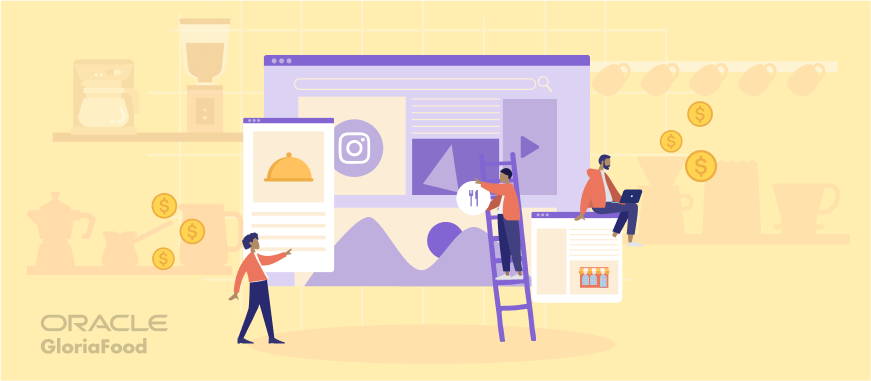- 1.What Is Restaurant Digitalization?
- 2.5 Benefits of Restaurant Digitalization
- 3.How to Approach Restaurant Digitalization
- 4.6 Essential Restaurant Digitalization Areas You Need to Develop
- Online food ordering and delivery
- Mobile ordering
- Search engine optimization (SEO)
- Restaurant marketing
- Data analytics
- Automated purchasing
- 5.The Takeaway (Pun Intended)
The food and beverage (F&B) sector has suffered terribly in the last few years. Thousands of restaurants had to close their doors permanently, and thousands more are struggling to break even. Competition is fierce and eateries have to stand out, and not just in terms of offering great food.
With most industries embracing digital transformation, why should F&B businesses be left behind? Restaurant digitalization is something that could make a real difference to your business, but what is it exactly and how can you make it happen?
What Is Restaurant Digitalization?
You may think that a restaurant doesn’t need digitalization. After all, it’s mainly about getting food to customers’ tables (or homes). But think about the different processes involved in your business and you’ll begin to see where it fits.
Digitalization is about using different tools and strategies to improve the customer experience, make your operations more efficient, and, of course, make significant savings.
By identifying the areas of your business where digitalization can make a difference, you can achieve those goals and make your business more streamlined.
It can start with something as simple as a virtual phone number and could go up to more complex systems such as a POS (point of sale) or online ordering system.
5 Benefits of Restaurant Digitalization
Here are several ways in which digitalization can help your restaurant:
- Streamlined customer journey: From allowing customers to order by scanning a QR code to paying for their food online.
- Better waste management: Every restaurant has food waste. Digitalization can reduce the amount of food you waste and provide solutions for waste disposal.
- Automated task management: You likely deal with multiple suppliers. By automating certain tasks such as invoice payment, you can streamline areas of your business operations.
- Lower energy costs: Any saving is a good thing, right? Restaurants can face massive energy bills and digitalization can help identify areas where savings can be made.
- Customer insights: Customer reviews do not only help drive new business to you (or away from you if they are not positive), but they can also provide you with insights that allow you to improve your business.
How to Approach Restaurant Digitalization
As with any radical change, you should approach restaurant digitalization carefully and plan out what it is you want to do and how you will do it.
List your goals
What is it you want to achieve through digitalization? By making a list of your objectives, you can better identify what technology or digital strategies can help you get to that point.
You can also prioritize what areas matter most to you, something that can be useful if you are working with a limited budget and have to space improvements out.
Audit current processes
What parts of your current setup would benefit most from digitalization? For example, a restaurant relies on good inventory control.
Are your current inventory management processes outdated and inefficient? If the answer is yes, then digitized inventory management is the way forward.
Formulate a strategy
Making a list of shiny new digital toys is all well and good, but how will you use them, and will they benefit your business and your customers?
Being able to tie digital tools to tangible benefits can help you implement them. For example, would you benefit from a table reservation system that can help you better anticipate the number of customers you’ll be serving daily? Or a fax from computer service to send internal communications without printing them on paper?
Implement and monitor digital tools
The final (but ongoing) part of your plan involves implementing the strategy and tools you have identified. For instance, you can install remote desktop software, which can empower your staff to access important systems and data remotely, ensuring smoother day-to-day operations. You should also be monitoring the effectiveness of any tech you decide on.
For example, in the case of an online ordering system, has it increased your online sales and streamlined the way you accept orders?
6 Essential Restaurant Digitalization Areas You Need to Develop
Restaurant digitalization is not just about obtaining new tools and technology. You also have to consider the effort you and your staff need to put in to reach new customers and make your new digital strategy successful.
1. Online food ordering and delivery
The first and most obvious area you need to digitalize is accepting food orders. Forget about pen and paper orders and implement an in-house food ordering software that allows you to accept orders on your smartphone.
It only takes 10 minutes to set up online ordering for free with GloriaFood:

2. Mobile ordering
A branded mobile app could take your ordering experience to the next level. Consider getting a dedicated app that customers can download on their smartphones and use every time they crave your delicious food.
3. Search engine optimization (SEO)
One of your main goals as a restaurant owner is to get potential new customers to find your restaurant website online. An effective SEO strategy can help your website stand out. It can also provide a good ROI as it needs little investment but can produce significant results.
You can use a restaurant website builder to generate your very own SEO and sales-optimized website in minutes. Here’s how:

4. Restaurant marketing
As with any business, restaurants rely on digital marketing to reach out to people on different platforms. Of course, the F&B sector also relies on a level of ‘word of mouth’ marketing but where do you think people are talking about your restaurant? Online, of course.
Monitor reviews across all social media and third-party platforms and use these platforms to attract more customers to your restaurant by posting mouthwatering food photos and irresistible promotions.
5. Data analytics
How many of your website visitors have actually placed an order online? Keeping a close eye on your restaurant data can help you analyze your website funnel and orders.
In turn, this can help you make informed decisions as to what can be improved when it comes to your website and takeaway marketing strategy.
6. Automated purchasing
There is nothing worse than running out of an ingredient in the middle of a busy day. By linking a purchasing system to your inventory management tool, you can avoid this issue. When an item is running low, the relevant supplier gets an automatic notice.
These systems can also identify patterns and help you forecast what items will be needed and when. This can take into account supplier lead times and seasonal fluctuations.
The Takeaway (Pun Intended)
No matter what type of restaurant you own and what cuisine you serve, there are some common restaurant digitalization tools that every owner needs.
The thing to remember is that, like any new process, restaurant digitalization should be well thought out and planned. There is little point in investing in new technology or tools that will not offer your business a good ROI.
This article is a guest post.
